| |
| |
Photographer,
Location |
Images |
Comments |
|
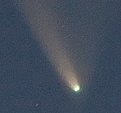
|
Lance
Andrewes,
Upper Hutt, New Zealand
Jan. 27, 2007 |
#1 |
After
two weeks of cloudy evenings, luck was finally with me.
Photo
details: Canon
20D, 70-200
mm lens @ 200mm, 4 sec exposure at f/5.6. Taken at 21:49
NZ Daylight Time. |
|
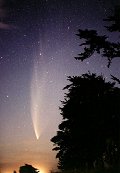
|
Ian
Cooper,
Glen Oroua, Manawatu, North Island, New Zealand
Jan. 26, 2007 |
#1,
#2 |
Even
with a 1st quarter moon around the tail could be seen out
to 25 degrees, and this became 30 when the moon set. The
magnitude of the coma was about +2.1, The overall appearance
has gone from being a mirror image of Comet West to looking
like Ikeya-Seki in reverse.
Photo
details: Nikon F camera, 50mm
lens at f/2. 30 second exposures on Fuji Xtra 800 film.
|
|
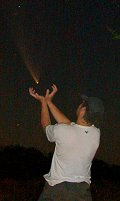
|
Marcelo Brignardello,
CHAJARI, Entre Rios, Argentina
Jan. 26, 2007 |
#1 |
Atrapando el
cometa para ti - 21:23 hs.!
Photo
details: SONY
DSC-H1, ISO200, 30s, F3.5
|
|
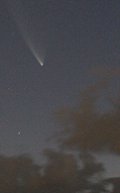
|
Barry Kilner,
Brighton , South Australia
Jan. 27, 2007 |
#1,
more |
The moon was
very bright tonight and we could see our shadows, but that
didn't stop Comet McNaught, still an easy naked eye target.
Photo
details: Canon
20D, 18-55
mm lens, iso 1600.
|
|
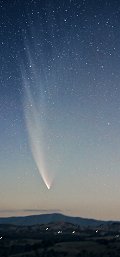
|
Gary Hill,
Wingham, N.S.W. Australia
Jan. 26, 2007 |
#1 |
Photo
details: Canon
300D, 80 second exposure (piggybacked on EQ mount),
35mm
lens @ f/3.5 set to ISO 400.
|
|
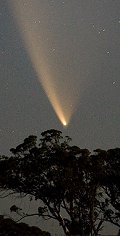
|
Rudi
Vavra,
near Moss Vale, New South Wales, Australia
Jan. 26, 2007 |
#1,
#2, #3 |
Comet
McNaught does not seem to mind the moonlight too much. It
is still a strikingly beautiful comet with a tail that easily
spans over 20 degrees, even in these conditions.
Photo
details: Canon
EOS 5D, 24mm
lens, f/2.8, ISO 1600, 30 sec. |
|
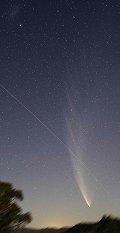
|
Grahame
Kelaher,
Mudgee Observatory, NSW, Australia
Jan. 26, 2007 |
#1,
more |
Comet
McNaught is still putting on a great show, evan under a
57% moonlit night. This shot has the International Space
Station transiting and the small Magellenic cloud visible.
Photo
details: Canon
20D, ISO400, f3.5, 309 seconds. |
|
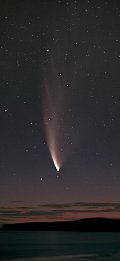
|
Trevor
Mackie,
Cape Bridgewater, west of Portland Victoria, Australia.
Jan. 25, 2007 |
#1 |
Photo
details: Canon
5D, Hutech modded, 50mm
lens, f/1.4 @1.4, 13 second exposure at ISO 3200. |
|
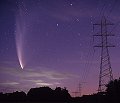
|
Alan
Yim (Berrynose),
Torquay, Victoria, Australia
Jan. 24, 2007 |
#1,
#2, more |
Comet
by the power transmission lines. The sky was lit by the
quarter moon that was probably the reason why a large part
of the comet's dust tail faded away.
Photo
details: Nikon
F3, Fuji Provia 400F exposed at ISO 800, 15-30 sec,
50mm
lens at f/1.2 - f/2.0 |
more
images: from
Bruce Kercher on Palm Beach near Sydney, Australia; from
Mike Smith of Bowral, New South Wales, Australia; from
James Stewart of Adelaide, South Australia;
|
|